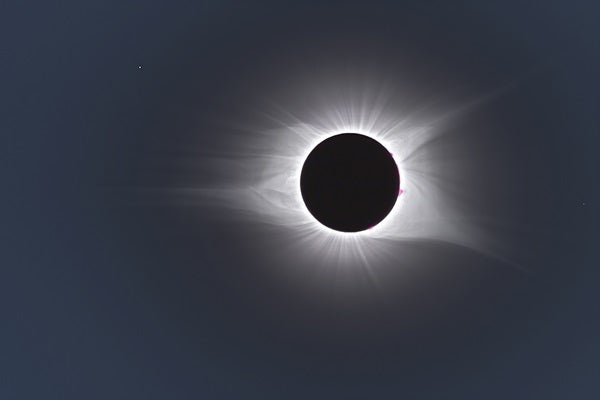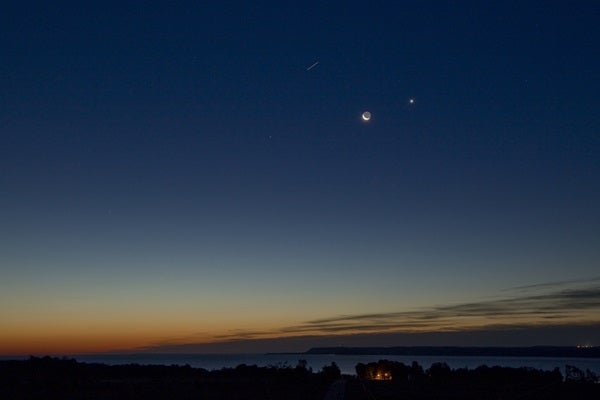Look high in the northwest after darkness falls, and you’ll be greeted by the familiar sight of the Big Dipper. The dipper is the most conspicuous asterism — a recognizable pattern of stars that doesn’t form a complete constellation shape — in the entire sky. It forms the body and tail of Ursa Major the Great Bear. Use the Pointers, the two stars at the end of the dipper’s bowl, to find Polaris, which lies due north for everyone north of the equator. Polaris marks the end of the Little Dipper’s handle. On June evenings, the relatively faint stars of this dipper arc almost directly above Polaris.
Saturday, June 29
For people who live near 35° north latitude, today marks the latest sunset of the year. Although Earth’s summer solstice and the Northern Hemisphere’s longest day occurred on the 21st, latest sunset happens several days after and earliest sunrise several days before. The specific dates depend on your latitude, however. In general, latest sunset occurs closer to the solstice the farther north you live.
Sunday, June 30
Saturn will reach its peak at opposition in less than two weeks, though it looks nearly as good now. The ringed world shines at magnitude 0.1 against the background stars of northern Sagittarius, a region that stands some 15° high in the southeast as twilight fades to darkness. If you target Saturn through a telescope, you’ll see its 18″-diameter disk surrounded by a beautiful ring system that spans 42″ and tilts 24° to our line of sight.
This morning offers your best chance to see Venus all week. Use the waning crescent Moon as a guide. It stands 5° high in the east-northeast 30 minutes before sunrise, and Venus lies one binocular field to its lower left. Despite shining at magnitude –3.9, the planet barely shows up against the bright twilight. Although you might be able to track Venus for a few more days, it drops out of view by week’s end.
Tuesday, July 2
New Moon occurs at 3:16 a.m. EDT. At most New Moons, our satellite tracks across the sky with the Sun and remains hidden from view. But today, the alignment between the Moon and Sun is perfect and people in the right locales can view a solar eclipse. Observers across much of South America and the South Pacific Ocean will see the Moon take at least a bite from the Sun. But people along a narrow path that runs from the Chilean coast near La Serena to the southern suburbs of Buenos Aires will witness a total eclipse, in which the Moon completely blocks the Sun’s disk. People watching the partial phases of the eclipse need to use safe solar filters to view it directly, but no eye protection is needed during totality.
Wednesday, July 3
Your best opportunity to see Mercury and Mars this week comes in tonight’s early evening sky, when you can use the one-day-old waxing crescent Moon as a guide. Luna appears 5° high in the west-northwest a half-hour after sundown. Once you find it, use binoculars to spy magnitude 1.8 Mars 3° to its upper left. Mercury glows a bit brighter, at magnitude 1.4, some 4° to the Red Planet’s left.
Thursday, July 4
No holiday better epitomizes summer in the United States than Independence Day. And the season’s namesake asterism — the Summer Triangle — will be on prominent display as fireworks ring out across the land. The trio’s brightest member, Vega in the constellation Lyra the Harp, stands nearly overhead in late evening. The asterism’s second-brightest star, Altair in Aquila the Eagle, then lies about halfway from the southeastern horizon to the zenith. Deneb, the luminary of Cygnus the Swan, marks the Summer Triangle’s third corner. Although it is this asterism’s dimmest star, it’s the brightest point of light in the northeastern sky.
If you ever thought the Sun’s distance controlled temperatures here on Earth, today should convince you otherwise. At 6 p.m. EDT, our planet reaches its most distant point from the Sun during 2019. At this so-called aphelion, the two lie 94.5 million miles (152.1 million kilometers) apart, some 3.1 million miles (5.0 million km) farther away than they were at perihelion in early January. The Northern Hemisphere’s warm temperatures at this time of year arise because the Sun passes nearly overhead at noon; during winter, the Sun traces a low path across the sky.
This week offers a good opportunity for binocular users to track down the northern sky’s brightest globular cluster. M5, whose 100,000 stars glow at a combined magnitude of 5.7, lies in the southwestern corner of the constellation Serpens the Serpent. You can locate it just 0.4° north-northwest of the 5th-magnitude star 5 Serpentis. Binoculars show the cluster as a hazy ball of light punctuated by a bright core.
The Moon reaches perigee, the closest point in its orbit around Earth, at 1:00 a.m. EDT. It then lies 226,009 miles (363,726 kilometers) away from us.
Saturday, July 6
Observers of the outer solar system can get a good view of Uranus before dawn. The best time to look for it is shortly before twilight begins around 3:30 a.m. local daylight time. Uranus then lies 20° above the eastern horizon among the background stars of southern Aries the Ram. This morning, use binoculars to find the magnitude 5.8 planet 2.3° south of the magnitude 5.7 star 19 Arietis. A telescope reveals Uranus’ blue-green disk, which spans 3.5″.
Sunday, July 7
Jupiter reached opposition and peak visibility nearly a month ago, but it remains a stunning sight from shortly after sunset until morning twilight starts to paint the sky. It resides among the background stars of southern Ophiuchus the Serpent-bearer, a region that climbs highest in the south around 11 p.m. local daylight time. Shining at magnitude –2.5, Jupiter is the night sky’s most conspicuous object with the exception of the Moon. When viewed through a telescope, the planet’s disk spans 45″ and shows striking cloud-top detail.












